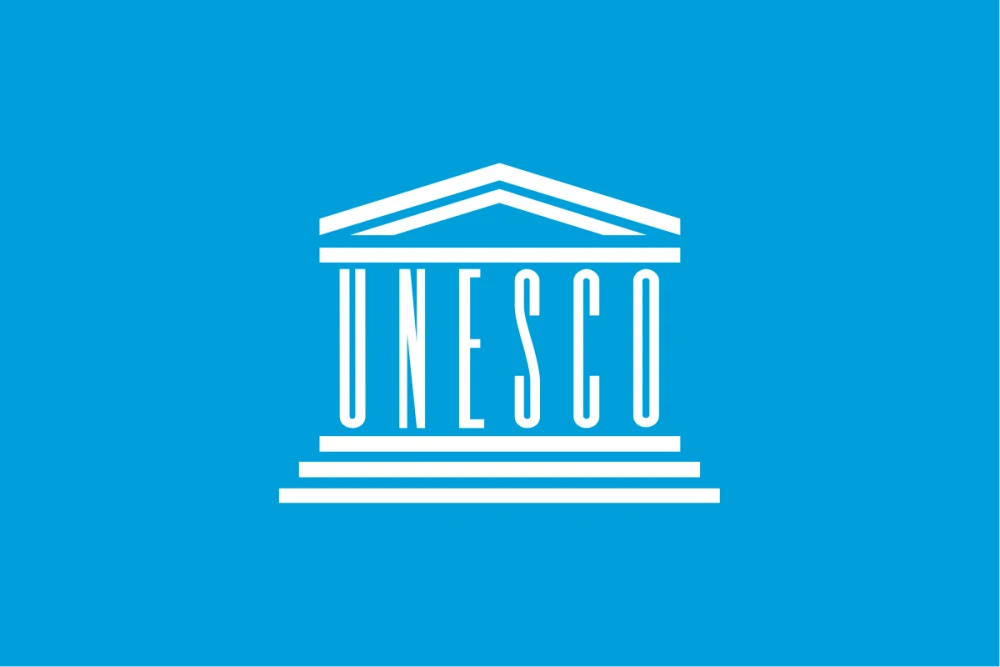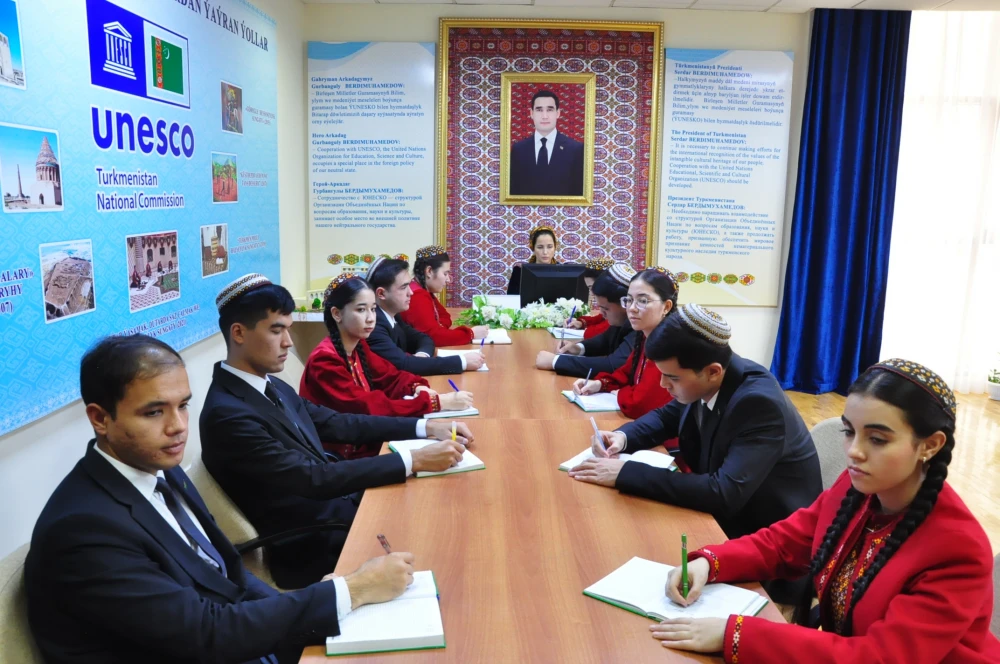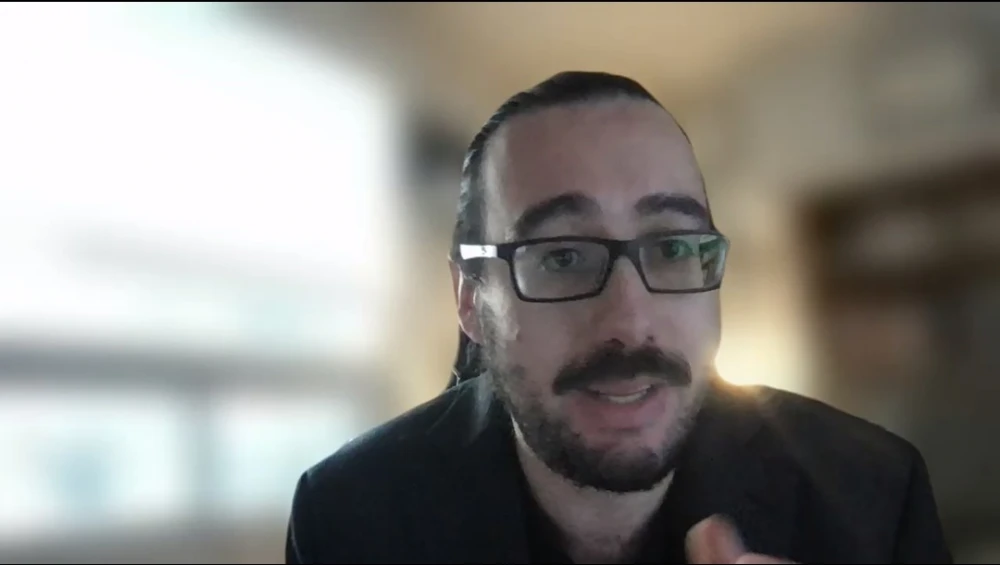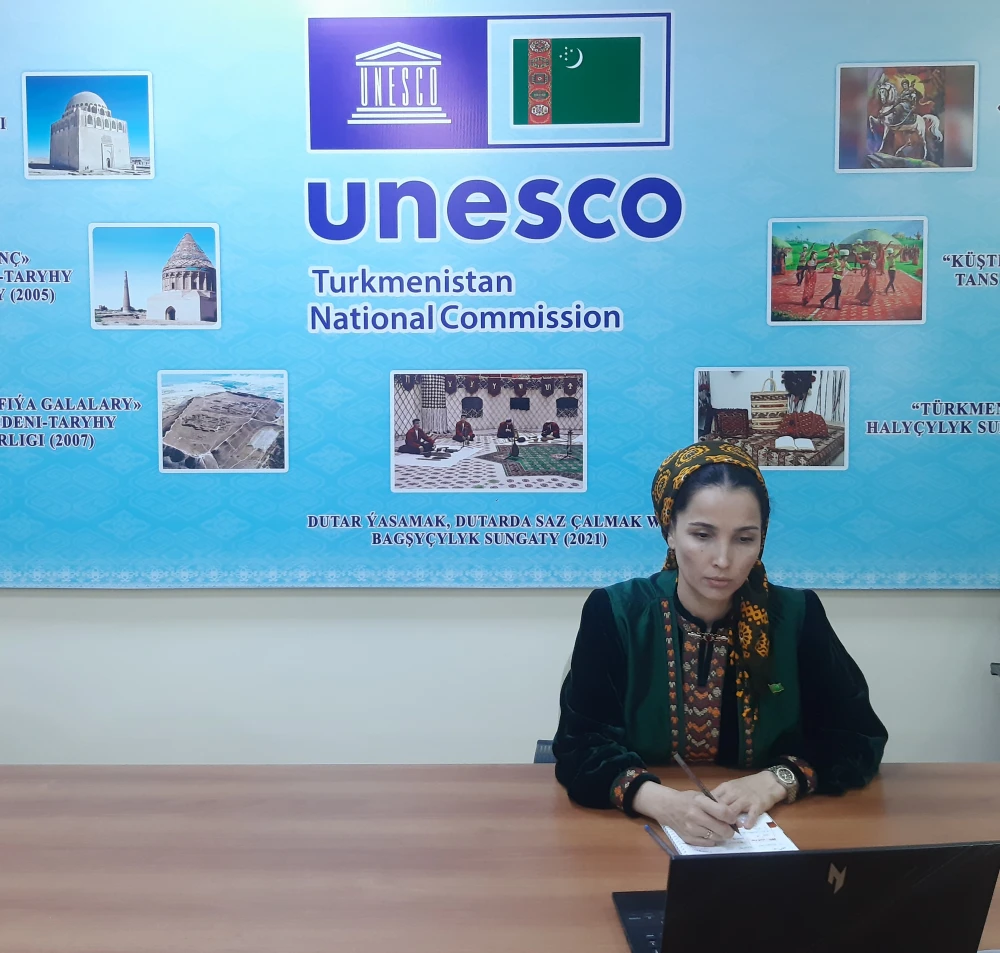
16/08/2023
2000
TURKMENISTAN – UNESCO: cooperation aimed to revive cultural And spiritual Heritage along the great silk road
Nowadays, in Turkmenistan the well thought-out state policy in the field of science, education and culture is being carried out under the leadership of Esteemed President Gurbanguly Berdimuhamedov. Radical changes taken place in these spheres provide for broad international cooperation. As stated by esteemed Presi- dent, the United Nations Educational, Scientific and Cultural Organization (UNESCO) is in harmony with the main area of the strategy for the strengthening of the foundations of security and the achievement of universal development.
The cooperation between Turkmenistan and UNESCO is based on equality and mutual respect and focused on the implementation of sociol-economic and humanitarian tasks through joint efforts in the name of comprehensive human development, the expansion of long-term cooperation in education, science, culture and information.
One of the UNESCO’s activities is the development of cultures without causing damage to the uniqueness and variety of cultures and the promotion of the development of national cultural values and the encouragement of the protection of cultural heritage. The cultural activity of UNESCO is to encourage creative work, to study and develop cultures, to preserve books, art works, monuments and the cultural uniqueness of traditions.
The implementation of social, economic and humanitarian tasks by joining efforts aimed at the comprehensive development of mankind and enhancing long term cooperation based on equality and mutual respect make the solid foundation of cooperation between Turkmenistan and UNESCO.
The President of Turkmenistan Gurbanguly Berdimuhamedov noted the need to enhance cultural cooperation at the meeting with the diplomatic corps of the country held on February 18, 2009, along with the main areas of foreign policy. “To disseminate general information about Turkmenistan and the Turkmen people, to carry out activities to familiarize with our country is a main task of Turkmen diplomacy and the direct duty of each of you. It is important to extend cooperation with the authoritative international organizations in this field, primarily with UNESCO”.
Turkmenistan has cooperated with UNESCO for the quarter of century. After signing the UNESCO Convention on August 17, 1993, Turkmenistan became the full-fledged member of this authoritative organization. On September 8, 1993, the government of Turkmenistan “On the Creation of the Turkmen National Commis- sion for UNESCO” was created. In December 1995, the Permanent Delegation of Turkmenistan to UNESCO was established in Paris. The Memorandum on Cooperation between Turkmenistan and UNESCO was signed in Paris on September 10, 1996. On February 4, 1997, the National Working Group for UNESCO was established with the Decree of the President of Turkmenistan.
Effective cooperation between UNESCO and Turkmenistan was established to preserve cultural and historical monuments, to study and disseminate heritage. Up to now, within the framework of the Convention Concerning the Protection of the World Cultural and Natural Heritage, in the territory of Turkmenistan more than 1000 historical and cultural monuments have been discovered and registered. In ancient Merv (1999), the monuments of Koneurgench (2005), the ancient Nissa fortress (2007) were included to the UNESCO World Heritage List. In different parts of the Turkmen land, which is full of ancient mysterious places, the Turkmen government together with foreign scientists carried out archaeological exca- vation work. Consequently, there were great discoveries. As a result of excavation work carried out for the past 30 years by world-known archaeologist Victor Ivanovich Sarianidi in Gonurdepe, considered as the capital of the Margush state, the new Margiana civilization was discovered, which was unknown in science and world civilization.
The inclusion of Merv, Koneurgench and Nissa, which used to be the main cultural centre between the South and the West in ancient times and the Middle Ages, to the UNESCO World Heritage List, the proposal made in 2011 to include 25 monuments of Turkmenistan located along the Great Silk Road is a clear evidence of the successful implementation of the large-scale international programs and scientific projects in the field of the safeguarding, study and revival of historical and cultural monuments.
It is worth noting that for over a decade Turkmenistan has cooperated with UNESCO effectively and productively. Esteemed President Gurbanguly Berdimuhamedov had a meeting with the former Director-General UNESCO Ms. Bokova during his official visit to the Republic of France on February 1-2, 2010. During the meeting Ms. Bokova stated that she was ready to continue the constructive cooperation with the government of Turkmenistan.
Effective activities are being conducted between UNESCO and Turkmenistan to promote cultural heritage. It is important to note that several international scientific conferences were held on this issue. With the support of UNESCO, in Turkmenistan, the following international conferences took place: “Historical and cultural heritage of the people of Turkmenistan and the East” (2002), “Turkmenistan is the Motherland of Anev culture and white wheat” (2004), “Permanently neutral Turkmenistan – UNESCO: assessment of historical-cultural values and definition of the ways of the safeguarding of the monuments of world heritage” in Ashgabat and Dashoguz (2006), in Mary “Ancient Margiana as a new centre of the world civilization”, “Nissa as an ancient hearth of the world cultural development” (2007), “Turkmen land as the hearth of ancient cultures and civilizations” (2008), “Cultural heritage as a source for the study of the history of world’s cultural and spiritual revival”, “New Renaissance Era and the ancient history of Dehistan”, “Nejmeddin Kubra and the spiritual and cultural world of the East”, “Ancient Jeytun – a cradle of early husbandry culture” (2009), “Gorogly” plot and the literature of the East”, “Literature and culture of the Seljuk era”, “Turkmenistan – in the view of travellers”, “Oguznama plot as a historical and cultural source” (2010), “Emergence of the Turkmen people and the history of the world civilization development” (2011), “Novruz – the holiday of peace and humanity” (2013), “Turkmenistan’s centuries- old architecture culture”, “South-East Turkmenistan’s heritage in the system of the ancient and medieval culture”, “Magtymguly Pyragy and universal cultural values”, “Role of Gorogly epic in the world culture” and others.
To restore and promote historical heritage along the Great Silk Road is an important area of the cooperation between Turkmenistan and UNESCO. These activities are conducted within the framework of the State Program for the scientific study and promotion of the national cultural heritage in Turkmenistan. As stated by our Esteemed President, “The Great Silk Road had a great positive impact on the development of mankind. This road became a starting point for the relations between the civilizations of the East and the West and created opportunities for the exchange of knowledge among different regions. The Great Silk Road, being great historical heritage, gives an imputes to the close interrelations among nations and states, contributes to the establishment of the political, trade and economic, cultural and humanitarian relations, serves as a solid foundation for the mutual understanding and cooperation, friendly relations between countries, regions and all continents”.
Several activities have been carried out to promote historical and cultural heritage of the Great Silk Road in the year, 2018, the slogan of which is “Turkmenistan is the Heart of the Great Silk Road”.
This great phenomenon acquired a new value in the book of the President of Turkmenistan titled Turkmenistan is the Heart of the Great Silk Road. In his book our National Leader, based on the Turkmen mentality, states that all this cultural wealth of the national culture has appeared around the monuments of the past which as the pearls strung on a thread form a precious necklace. It is an original ornament of our native land, and a thread binding – the Great Silk Road.
This is a new and right definition of the Silk Road. The ancient Turkmen land served as the heart of this famous international transport-trade-cultural sphere. Turkmenistan’s role, which became its mainspring, is of great significance at present time – in the new geo-political, geo-economic conditions of the 3rd millennium. Indeed, the significant role of the Great Silk Road in the cultural-civilizational development of mankind is studied and supported at the UN level. This has a positive impact on the intensification of cultural relations among nations and states along the Great Silk Road. Generally, it has a positive impact on the sustainable development of culture. In Turkmenistan, as a result of the state policy aimed to cherish, safeguard, study and promote, a lot of activities have been carried out to study the heritage of the Great Silk Road. The National Working Group for UNESCO, the Department for the Safeguarding, Study and Restoration of Historical Monuments of the Ministry of Culture of Turkmenistan has carried out several activities aimed to spread the glory and significance of the monuments.
The scope of cooperation with foreign experts in discovering and studying centuries-old ancient buildings has been expanded. At present, archaeological and excavation work is underway in the Ojaklydepe Monument in Mary velayat together with the Washington University in St. Louis (the USA), the Togalak-1 Monument of Mary velayat with the University of Bologna (Italy), in Ancient Nissa together with the Turi Archaeological Investigation and Excavation Centre for the Near East and Asia, in the Yylgynlydepe of Kaka etrap together with the Institute for the History of Mate- rial Culture of the Russian Academy of Sciences, in the Ulugdepe Monument jointly with the French Archaeology Group. Special attention is paid to the reliable safe- guarding of these historical buildings, monuments, which entered the gold treasure of the cultural heritage of mankind, and to their restructuring and restoration. Work aimed at studying, restoring historical findings, which is considered as one part of the cultural heritage of the world, also promotes the development of tourism.
It is known, main areas of the Turkmen section of the Great Silk Road, in the territory of the Karakum desert, caravanserais built by our ancestors, fortresses, castles, mosques and the remains of marvellous places make a great impression in our time as well. At present, work is under way at the transnational nomination to include the Great Silk Road at whole to the UNESCO World Heritage List.
Moreover, the Action Plan for the Nomination of World Heritage was adopted by Central Asian states and China in Dushanbe in October 2006. In May 2009 the abovementioned states agreed on the creation of the Intergovernmental Coordination Committee for the phased nomination of the Great Silk Road to the World Heritage List. In 2009, Xian city of China hosted its first meeting.
On May 3-6, 2011, the second meeting of the Coordinating Committee on the Serial World Heritage Nomination of the Silk Roads was held. This meeting was attended by ex- perts of 12 countries and officials of UNESCO World Heritage Centre, International Council on Monuments and Sites (ICOMOS), international institutions of Central Asia, and experts of the College of London University, the Raymond Lemaire International Centre for Conservation at the University of Leuven (Belgium). We are speaking about the world level safeguarding of historical and cultural monuments along the Great Silk Road.
In Ashgabat forum specialists examined the on-going work, carried out for several years, to include the Silk Road to the World Heritage List. At the same time, the clear borders of historical and cultural wonders have been identified. It was noted that it was envisaged to consider more important parts of 7,500 kilometers from about 35 thousand kilometres of different roads, 2500 monuments located around them.
29 marvellous cultural-historical monuments located along the Great Silk Road were proposed to include the preliminary list of the serial nomination of Turkmenistan’s cultural heritage. Many of them are located in the territory of Merv, Koneurgench, Nissa, which are added to the World Heritage List. They are, in addition to specialists, caravanserais, palaces, mosques, holy places. Specialists who attended the work of the Coordinating Council visited a range of those monuments, had an opportunity to witness the results of the state policy to cherish historical-cultural heritage. As an outcome of the meeting, the Ashgabat Agreement was adopted unanimously.
The Department for the Safeguarding, Study and Restoration of Historical Monuments of the Ministry of Culture of Turkmenistan is conducting work to prepare relevant documents regarding the inclusion of the Great Silk Road at whole to the UNESCO World Heritage at the transnational nomination and to train local specialists. The work is underway to study monuments located near the routes of the Great Silk Road along the present territory of Turkmenistan. Totally 70 of those monuments, including 9 in Ahal, 17 in Balkan, 11 in Dashoguz velayat, 25 in Lebap, 8 in Mary velayat were registered. Furthermore, great work is underway to discover monuments unknown up to now; safeguarding obligations are concluded with organizations. On December 23, 2016, the President of Turkmenistan adopt- ed a decree to create a special Fund to maintain and conserve historical and cultural monuments in order to strengthen the material base in the field of the safe- guarding of historical and cultural monuments located in the territory of our country. On October 8-18, 2018, in Ashgabat and in the state historical-cultural re- serve “Ancient Merv”, trainings were organized to prepare documents on the world heritage nomination of the Great Silk Road. The road between Amul-Merv was chosen to nominate to the list. On December 4-5, 2018, in Ashgabat, there was the fifth meeting of the Coordinating Committee on the Serial World Heritage Nomination of the Silk Roads. Furthermore, on December 6-7, the international conference titled “Importance of the Great Silk Road: Present and Future Development” will be held in Ashgabat. Representatives from about 40 countries are expected to arrive for the conference. On the eve of that forum, undoubtedly, the next Ashgabat forum will be of great significance in restoring and promoting the material-cultural heritage of the Great Silk Road of Turkmenistan.
At the international Conference the following sessions took place: “Policies and Good Practices by Countries along the Historic Path of the Great Silk Road for Achieving the UN 2030 Agenda”, “From Historical Routes to Modern High- ways: Revival of the Great Silk Road”, “Shared Heritage and Plural Identities along the Silk Road”, “Spreading of Culture through Commerce along the Great Silk Road”. Within the Ashgabat forum there was the photo exhibition titled “Youth Eyes on the Silk Roads”. The Participants of the international conference attend- ed the play “Gorogly and Agayunus” at the Alp Arslan Turkmen National Drama Theatre and the concert of the “Galkynysh” Turkmen-Austrian symphony orches- tra. Finally, as an outcome of the international conference, the Ashgabat Declara- tion was adopted.
Collaborating with UNESCO, successes were achieved in promoting Turkmenistan’s spiritual and cultural heritage; several activities are being conducted.
The UNESCO Convention on the Safeguarding of Intangible Heritage was adopted on October 17, 2003. Turkmenistan joined this Convention in 2011. In 2006-2007, with the assistance of UNESCO, the Centre for safeguarding national culture and folklore was created in Turkmenistan. On February 28, 2015, Turkmenistan’s decree “On the Safeguarding of Intangible Heritage” was adopted. This decree opens up opportunities for our country to nominate the spiritual values of the Turkmen people to the UNESCO Intangible Heritage List.
Within the framework of the mentioned Convention, Turkmenistan has achieved good results. In particular, on December 2, 2015, during the tenth ses- sion of the UNESCO’s Interstate Committee (Windhoek Capital city, Namibia) “Gorogly epic art” was included into the Intangible Cultural Heritage List. In December 2016, this List was augmented with the International Novruz Holiday. On December 4-9, 2017, during the regular meeting of the above-mentioned Commit- tee of UNESCO held in the city of Cheju city of the Republic of Korea, “Kushdepdi song and dance” was also added to the aforesaid list. Necessary informa- tion was submitted by the National Group of Turkmenistan for UNESCO Affairs in order to nominate the “Turkmen carpet-weaving art” for the inclusion to the list.
During the meeting with the diplomatic corpus of our country held on February 18, 2009, the President of Turkmenistan gave a special instruction to the Permanent Delegate of Turkmenistan to this organization for taking necessary steps to include Turkmenistan’s unique and impressive natural places into the UNESCO list. Within the framework of the close cooperation, proposals were developed and submitted to add the impressive places of the Turkmen nature, six state natural reserves, i.e. Sunt-Hasardag, Bathyz, Amyderya, Repetek, Hazar, Koytendag reserves having the paths of dinosaurs, as well as the ecosystem of the wonderful Karakum desert to the UNESCO list. These natural monuments are nominated due to their uniqueness. On November 9-17, 2009, in the “Bathyz” state natural reserve a training seminar was organized with the help of the National Group for UNESCO Affairs of Turkmenistan in order to prepare for the nomination of natural monuments of Turkmenistan to the UNESCO World Heritage list. The representatives of the Headquarter in Paris also took part in the seminar. In May 2012, Koy- tendag attracted the attention of many scientists from different countries. Interna- tional expeditions were organized there to study those marvellous places – plateaus, karst caves, ground lakes and others.
As a result of the election of our country to the UNESCO Executive Council for 2013-2017, the scope of cooperation of this organization has been further expanded. The assessment of the heads of this structure for the content and quality of science and education as a result of modern scientific and educational reforms carried out under the leadership of Esteemed President is rather prideful.
The exemplary work in the field of science, education and culture of the Head of Turkmenistan was recognized at the level of UNESCO. On May 6, 2009, the President of Turkmenistan was awarded the highest award of UNESCO – a gold medal “Avicenna”. Rewarding our Esteemed President, who has all features of scientist-doctor, with a golden medal created by the large international organization and named after Ibn Sina, granted to the heads of state, has a symbolic meaning.
Furthermore, during the leadership of Esteemed President in the sphere of science, education, healthcare and medicine, the famous scientist’s book titled “Laws of Medicine” was translated into the Turkmen language and published. This award is a clear evidence of the recognition by the international community of the humane work carried out by Esteemed Head of State for many years.
Further development of the effective cooperation with UNESCO will serve as a solid foundation for the strengthening of joint efforts to protect and promote Turkmenistan’s rich cultural and historical heritage and its wonderful natural monuments.
Jumamyrat Gurbangeldiyev,
Institute of International Relations of
the Ministry of Foreign Affairs of Turkmenistan.
Magazine "Foreign policy and diplomacy of Turkmenistan" volume 4, 2019
Soňky täzelikler

03/12/2025
Onlaýn açyk sapak geçirildi
